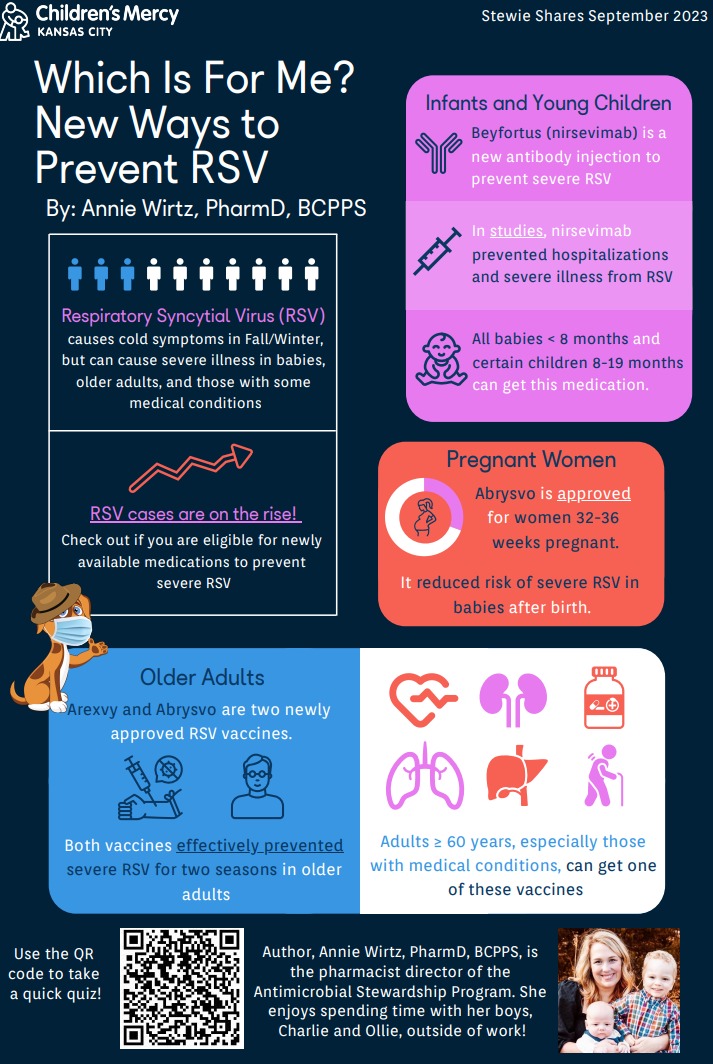Link Newsletter - September 2023
Our September issue features the latest news and updates on pediatric care from Children's Mercy clinicians.
G-Tube Troubleshooting: Tips and Tricks for the Primary Care Provider: Evidence Based Strategies
Gastrostomy tube (i.e., G-tube) placement is one of the most common surgical procedures in pediatrics, with an estimated 1.4 million children born every year with a condition that requires assisted feeding with a nasogastric or gastrostomy tube. Despite the high prevalence of this procedure, it is associated with one of the highest rates of hospital revisit, approximately 30% within 30 days of placement. At one institution, G-tube-related complaints accounted for an average of 1.6 emergency department (ED) visits each day, taking an average 4.6 hours to resolve.
Nirsevimab, the First Monoclonal Antibody Approved for All Infants: Vaccine Update
This is it – the opportunity to protect infants from respiratory syncytial virus (RSV), the leading cause of hospitalization among U.S. infants.1 Each year in the United States, RSV leads to 2.1 million outpatient (non-hospitalization) visits, 58,000-80,000 hospitalizations and 100-300 deaths in children under the age of 5.2 After U.S. Food and Drug Administration (FDA) approval of nirsevimab in July 2023, many immunization professionals eagerly listened to the Advisory Council on Immunization Practices (ACIP) meeting on Aug. 3, 2023. You could hear the excitement in the room as the Vaccines for Children (VFC) resolution was approved and the votes for first season and second season (for high-risk groups) immunization passed for the first monoclonal antibody approved for all infants. The projected rollout for nirsevimab is early October.
Buckle Fractures in Children: State of the Art Pediatrics
Pediatric buckle fractures are a common injury pattern, estimated to occur in about 1 in 25 children and usually occurring about the wrist.2 A buckle fracture may also be referred to as a torus fracture, so named because it is an incomplete injury to the outer layer of bone which creates a bulge or protuberance, “torus” in Latin. The porosity and relative flexibility of the juvenile skeleton lends itself to this unique fracture pattern in children. The most common location for a buckle fracture is the distal radius at the wrist; however, these injuries may also occur about the distal tibia near the ankle, or any other bone subject to axial loading.
Nirsevimab and RSV: Long-Term High Hopes and Short-Term Cautious Optimism: Outbreaks, Alerts and Hot Topics
A new monoclonal antibody to prevent RSV, nirsevimab (Beyfortus), has been approved and recommended by the Advisory Committee on Immunization Practices (ACIP) for all infants less than 8 months of age entering their first RSV season and for at-risk children entering their second season.
Stewardship School: Which Is For Me? New Ways to Prevent RSV
Check out the monthly "Stewie Shares" infographic from our Antimicrobial Stewardship team. This one-page, visually rich flyer contains information for both clinical and non-clinical audiences on current issues related to antimicrobial topics. You are welcome to print and post or link to it from your practice's website.
In the September edition, learn about how to prevent RSV this fall and winter.

We want to hear from you!
Do you have ideas, questions or suggestions for future articles in The Link? Send us a note at thelink@cmh.edu.
Learn More and Subscribe to The Link
 Visit the homepage for The Link to:
Visit the homepage for The Link to:
- Find out more about the content and authors featured in The Link
- Subscribe to receive future issues by email
- Read past articles in the archive